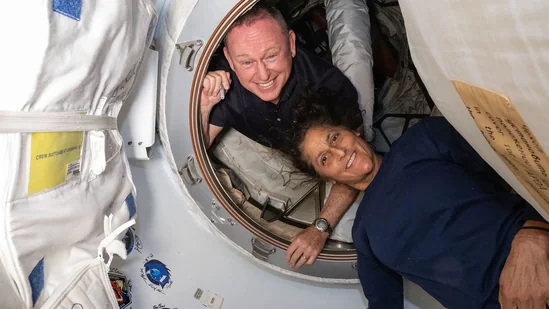After spending over 250 days aboard the International Space Station (ISS), NASA astronaut Sunita Williams and her colleague Barry “Butch” Wilmore are finally preparing for their much-anticipated return to Earth. Initially, their mission was scheduled to last only eight days, but unexpected technical issues with their spacecraft led to an indefinite extension. Now, NASA and SpaceX have officially scheduled their return for March 2025, offering relief to space enthusiasts and the astronauts’ families.
Background: How Sunita Williams’ Mission Got Extended
Launch and Initial Plans
- Launch Date: June 5, 2024
- Spacecraft: Boeing’s Starliner (First Crewed Mission)
- Original Mission Duration: 8 Days
- Mission Goal: Test Starliner’s capability for future space travel
NASA sent Sunita Williams and Butch Wilmore on a historic mission to test Boeing’s Starliner capsule in real-world conditions. However, what was meant to be a short stay at the ISS turned into an unexpectedly long mission due to multiple technical malfunctions in their return vehicle.
The Starliner’s Technical Challenges
Shortly after docking at the ISS, the Starliner exhibited major issues, including:
- Helium leaks in the propulsion system
- Malfunctioning thrusters, making a safe return uncertain
- Software bugs affecting navigation systems
Due to these serious technical risks, NASA decided not to bring the astronauts back using Starliner, instead opting for an uncrewed return test flight in September 2024 to investigate the problems.
How Sunita Williams and Butch Wilmore Adapted to the Extended Stay
Despite their unexpectedly prolonged mission, Williams and Wilmore have adapted remarkably well.
- Continued Research & Experiments: They actively participated in scientific experiments related to human physiology, biology, and technology demonstrations.
- Maintenance Work: They contributed to repairs and spacewalks, playing a key role in keeping the ISS functional.
- Psychological Resilience: Both astronauts remained positive despite uncertainty, with Sunita Williams stating:
“I don’t feel abandoned. I don’t feel like we’re stuck up here.”
NASA’s New Return Plan: Crew Dragon to the Rescue
How NASA is Bringing Them Home
After months of uncertainty, NASA has finalized their return plan:
- New Vehicle: SpaceX’s Crew Dragon capsule
- Planned Return Window: Mid-March 2025
- Launch of Replacement Crew: March 12, 2025
NASA will send a new team of astronauts to the ISS using a previously flown Crew Dragon vehicle, allowing Williams and Wilmore to board it for their return journey.
This marks a significant shift, as it will be the first time NASA is relying on SpaceX to return astronauts from an unplanned extended mission instead of Boeing’s Starliner.
Public and Political Reactions to the Delay
Growing Public Concern
As the mission dragged on, concerns mounted among the public, experts, and policymakers:
- Health Risks: Prolonged stays in space can cause muscle atrophy, weakened immune systems, and vision problems.
- Mental Well-being: Isolation and uncertainty can psychologically strain astronauts.
- Mission Costs: The delay increased NASA’s operational expenses, raising questions about Boeing’s accountability.
Trump’s Public Appeal to Elon Musk
Even former U.S. President Donald Trump stepped into the discussion. Reports suggest that Trump personally urged Elon Musk to expedite the return of the astronauts using SpaceX’s Dragon capsule.
“Why are we still waiting? Get them home safely.” — Donald Trump (Reportedly to Elon Musk)
While NASA made independent decisions, Trump’s involvement highlights how the incident turned into a national conversation.
Astronauts’ Health and Readjustment Post-Spaceflight
Even though Williams and Wilmore remained healthy, extended space missions have unique challenges.
How NASA is Preparing for Their Return to Gravity
Once back on Earth, the astronauts will undergo:
- Intensive Medical Checks: NASA will monitor their muscle strength, bone density, and cardiovascular health.
- Rehabilitation Therapy: Since prolonged weightlessness weakens the body, they will need months of physical therapy.
- Psychological Support: Readjusting to Earth’s gravity, social interactions, and daily life can be mentally demanding.
What This Means for Future Space Missions
Lessons Learned from the Starliner Crisis
The Starliner’s failure was a major setback for Boeing, raising concerns about:
- Reliability of commercial spaceflight partners
- Future NASA missions using Boeing’s technology
- The importance of alternative emergency return options
The Rising Dependence on SpaceX
SpaceX’s Crew Dragon has repeatedly proven reliable, making it NASA’s go-to option for:
- ISS missions
- Emergency astronaut rescues
- Upcoming deep-space projects
This event further solidifies Elon Musk’s SpaceX as the dominant player in the commercial spaceflight industry.
A Historic and Unexpectedly Long Mission
Sunita Williams and Butch Wilmore’s mission started as a routine test flight but turned into a historic long-duration stay aboard the ISS. Now, as they prepare to return to Earth, NASA, SpaceX, and the global space community eagerly await their safe homecoming.
This mission will leave a lasting impact on the future of commercial space travel, teaching valuable lessons about technical reliability, astronaut resilience, and the importance of contingency planning in space exploration.
By – Nikita
ALSO READ – Action Films for ‘Mission: Impossible’ Fans



